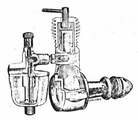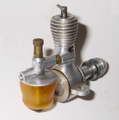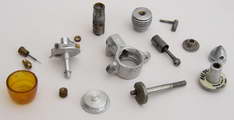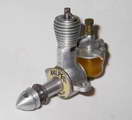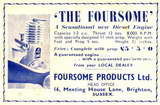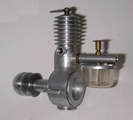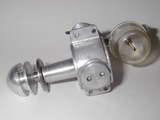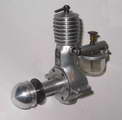Kalper and 4-some:
The Seymour Hylda Story
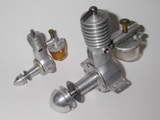 |
||
| Click on images to view larger picture. | ||
If you were to head down south of London to the Channel Coast at Brighton, as well as the legendary Pier, you'll be in the area once occupied by a long-forgotten English manufacturer of some rather interesting early diesel engines—the Kalper and the 4-Some.
Most serious afficionados of the early model aero engine have heard of the Kalper .32 diesel engine, but relatively few could rattle off the name of the manufacturer! This delightful little miniature sideport diesel was made in relatively small quantities by an obscure firm called Seymour, Hylda & Co of Southwick, Sussex. Southwick is on the south coast of Sussex and is in effect a suburb of Brighton, lying a little to the west of the town centre. The engines were exclusively distributed by the well-known firm of Arthur Mullet of 16 Meeting House Lane, Brighton.
How Seymour, Hylda & Co, Engineers' Instrument Makers became involved with model engine production is a complete mystery. There is one straw in the wind which might possibly yield some further information if it could still be followed up after all the intervening years. In his 1947 book Model Diesels, D J Laidlaw-Dickson noted that a Brighton firm known as Myers & Young of 46 Stanley Street, Queen's Park, Brighton, were making plans to enter the model diesel engine field, although these plans had not then matured to the point where any of their products could be described. History tells us that Myers & Young never subsequently appeared as manufacturers at any time. It thus appears possible that Seymour, Hylda & Co may have taken over Myers & Young's diesel development program. However, this is pure speculation which is included simply as a possible subject for further investigation.
The Kalper .32 was certainly in production between 1948 and 1951 inclusive. I have been informed by a presumably knowledgeable source that production ceased in late 1951 or early 1952, but I cannot confirm this from my own direct knowledge.
 There were two distinct versions of this delightful little motor. The Mk I (or perhaps A) version was a conventional sideport design having the intake enter the crankcase at the rear. The engine featured a single bypass at the front and twin exhaust ports, one on each side. Working geometry was drastically under-square—bore and stroke were 6.37 mm x 10.21 mm for a displacement of 0.324cc and a bore/stroke ratio of 0.62! This version of the engine was the subject of an "Aeromodeller" test by Lawrence Sparey which appeared in the November 1948 edition of that magazine. Sparey obtained 0.0099 BHP at 10,250 rpm and was quite complimentary about the engine in general.
There were two distinct versions of this delightful little motor. The Mk I (or perhaps A) version was a conventional sideport design having the intake enter the crankcase at the rear. The engine featured a single bypass at the front and twin exhaust ports, one on each side. Working geometry was drastically under-square—bore and stroke were 6.37 mm x 10.21 mm for a displacement of 0.324cc and a bore/stroke ratio of 0.62! This version of the engine was the subject of an "Aeromodeller" test by Lawrence Sparey which appeared in the November 1948 edition of that magazine. Sparey obtained 0.0099 BHP at 10,250 rpm and was quite complimentary about the engine in general.
The Mk II (or perhaps B) version was generally similar in its basic design but did feature a few significant departures from its predecessor. It retained the same bore and stroke but displayed several significant changes in terms of its induction set-up. For one thing, the induction port in the cylinder now entered at the right side of the case instead of at the rear. For another, the induction tube itself was significantly more complex, featuring a 90 degree Z-bend at the point where the fuel pickup entered from below and the needle entered from above. The result of this was that the fuel jet was (most unusually) aligned along the axis of the airflow rather than at the conventional 90 degrees.
This version of the engine was tested in Model Aircraft in March 1951, and the excellent cut-away drawing which appeared with that test clearly shows the unusual carburetion arrangements. This test yielded a figure of 0.016 BHP at around 10,000 rpm—well up on the Sparey figure. It's hard to see why—I would have said that the rather convoluted induction tube of the Mk. II would more likely have restricted power rather than enhancing it! Perhaps it was down to the conditions of the test and possible equipment variations. The engine was given a quite favourable "report card" in this test.
From the 1951 cut-away drawing, the Kalper cylinder retention was a bit unisual as there was no positive means of locating the height of ports above the crankshaft axis. Instead, the cylinder screwed into the case until the ports were at about the right height and orientation, then the head was screwed down, acting as a "lock nut" on the cylinder liner. The liner would have to be held in place during this operation to keep the ports correctly aligned—maybe by poking a drill bit through the exhaust. On the plus side, the timing could be varied to a degree. Unusual to say the least. As all threads were extremely fine (60 TPI Ed), great care is needed in handling these little gems. For this reason, I decided to leave well enough alone, but within weeks of this article being released on Ron's Model Engine News web site, a reader had sent in photos of a fully disassembled Kalper, as seen here. So to see how it actually goes together, visit the Kalper Construction Details page.
A "modern" replica of the Mk II Kalper was made some years back for the collector market—having an original myself, I didn't bother. Probably should have done!
The is my own original Kalper .32 Mk II which I obtained many years ago from its original owner, a formerly well-known competitor in English modelling circles. He bought it new in 1950 from Arthur Mullet. It has had quite a bit of use but remains in excellent condition throughout. It starts and runs very well indeed; surprisingly so for such a small engine—no vices at all! Note the plastic disc which is pressed onto the front bearing unit—it bears the name Kalper plus the manufacturer's name and location. Serial number is B 496. I note that the serial number of the one tested in Model Aircraft (which was on loan only) was B 538. I wonder if the first model was designated A and the second model by B? We'd need to find a first model to check this and they definitely are like rocking horse droppings!
The name of the engine is intriguing—why Kalper? That's a rather "foreign-sounding" name to be applied to a British diesel, surely, and it has no obvious connection with the makers' name. The implication here is that someone by the name of Kalper must have had a hand in the design and perhaps the production of the engine. We shall probably never know.
So far, so good—nothing that radical here! But now it gets much more interesting. Arthur Mullet was also the distributor for the larger 1.2 cc "4-Some sideport" diesel (note the address for "4-Some Products" is his model shop address). This engine and locality of the distributor is mentioned in Fisher's book (page 40) and confirmed by the Aeromodeller advertisement.
In most respects, the 4-Some is extremely similar to the Mk I Kalper (or perhaps vice versa). In addition to a very similar overall appearance, it has the rear-entry intake and the same general method of construction. But in the case of the 4-Some, things are structurally more complex, for reasons which escape me! The cylinder liner is inserted from below and sealed after assembly with a threaded plug. Weird, and one wonders why?! The twin exhaust stubs are faced and internally tapped, indicating that some kind of threaded extension stacks could be installed if desired. The photos shows my own example of this rather obscure and nowadays extremely rare motor. The serial number of this example is G 915—similar in style to the Kalper numbers, but they evidently used the G designation to designate this model.
I've never dismantled this engine beyond removing the bottom access cover to measure the stroke (I measured the bore through the opposing exhaust ports), so I was not absolutely clear regarding what holds the cylinder in its correct radial alignment once it's inserted. The front cover is held on by 6 rather fragile-looking brass countersunk screws rather than being simply screwed in as on the Kalper. All a bit mysterious, but an earlier version of this page was seen by Eric Offen who just happened to have a 4-Some in pieces for restoration, so now the actual assembly details can be revealed.
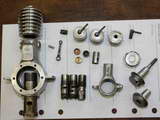 The 4-Some sports what must be the most unusual cylinder rentetion method of all time. As suspected, the cylinder is inserted through the "Welsh Plug" like opening in the bottom of the crankcase. The top section is threaded so that the cylinder head acts as a nut, drawing the liner up into the case until a flange on the bottom of the liner is pulled onto a seat turned in the bottom of the bored crankcase. The milled flat on the front of the liner provides the transfer passage and assists during assembly allowing the liner to be held in the correct orientation and prevented from turning while the head "nut" is cinched up—perhaps with a purpose-made factory tool, or perhaps by a screwdriver blade!
The 4-Some sports what must be the most unusual cylinder rentetion method of all time. As suspected, the cylinder is inserted through the "Welsh Plug" like opening in the bottom of the crankcase. The top section is threaded so that the cylinder head acts as a nut, drawing the liner up into the case until a flange on the bottom of the liner is pulled onto a seat turned in the bottom of the bored crankcase. The milled flat on the front of the liner provides the transfer passage and assists during assembly allowing the liner to be held in the correct orientation and prevented from turning while the head "nut" is cinched up—perhaps with a purpose-made factory tool, or perhaps by a screwdriver blade!
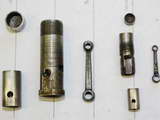 This photo, also provided by Eric, shows the Kalper and 4-Some cylinders, pistons and rods, side by side. The similarities are astounding and provide strong circumstantial evidence that the two engines were a product of the same designer through the proportions of the piston, placement of the wrist pin, and use of the cooling fins as a "lock nut" for the cylinder liner. The long piston may be due to the influence of Lawerence Sparey whose early writings had advocated this as a way of achieving the strong compression required by a diesel. The common, low wrist pin location provides a strong family similarity, but is actually dictated by geometry as placing it any higher would cause it to strike the sides of the piston at its point of maximum sideways deflection (when the the axis points of crankshaft, crankpin, and wrist pin form a right angle triangle).
This photo, also provided by Eric, shows the Kalper and 4-Some cylinders, pistons and rods, side by side. The similarities are astounding and provide strong circumstantial evidence that the two engines were a product of the same designer through the proportions of the piston, placement of the wrist pin, and use of the cooling fins as a "lock nut" for the cylinder liner. The long piston may be due to the influence of Lawerence Sparey whose early writings had advocated this as a way of achieving the strong compression required by a diesel. The common, low wrist pin location provides a strong family similarity, but is actually dictated by geometry as placing it any higher would cause it to strike the sides of the piston at its point of maximum sideways deflection (when the the axis points of crankshaft, crankpin, and wrist pin form a right angle triangle).
There's no plastic ring on the front of the 4-Some. The "4-SOME" designation is cast into the front of the casting on the transfer port, and is highlighted by the use of an area of green paint surrounding the identification. The former owner assured me that the engine was supplied in that state. He also recalled that some of them were painted red, but I can't confirm that. In contrast, the example shown on page 73 of Clanford's A-Z has no enameling at all.
This example has clearly done a fair bit of running, but all fits remain very good. Overall, both the Kalper and the 4-Some are extremely well made where it counts. The 4-Some starts very easily indeed and runs very steadily. But power is not too impressive and vibration levels are high. Certainly, the engine is no match at all for its contemporary rival, the Mills 1.3. My informant told me that it had a very short production life, and I believe him. If you had a choice between this one and a Mills, it would be no contest!
Now for the surprise. I got this engine and the Kalper from a formerly well-known British modeller who told me that he had bought this one too from Arthur Mullet around 1949, and that from his own direct knowledge, the 4-Some and the Kalper were both made by the same Brighton firm, our old friends, Seymour, Hylda & Co. No advertising we've been able to track down confirms this, but none contradicts it either. Advertising for both engines disappeared from the model press in the early 1950s. For all this time, the 4-Some appeared exclusively in Arthur Mullet's advertising, while the Kalper disappeared from his list of engines in 1949 and re-emerged in the advertising for South Coast Models, another Brighton model shop.
Anyway, that's about all that can still be gleaned about a little-known Brighton company who made some rather interesting engines which deserve to be remembered. If anyone out there knows more, let's hear from you!!
This page designed to look best when using anything but IE!
Please submit all questions and comments to
[email protected]
|
Unless otherwise expressed, all original text, drawings, and photographs created by
Ronald A Chernich appearing on the Model Engine News web site are licensed under a Creative Commons Attribution-Noncommercial-Share Alike 3.0 License. |

|

